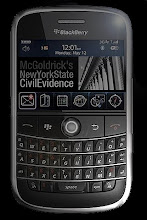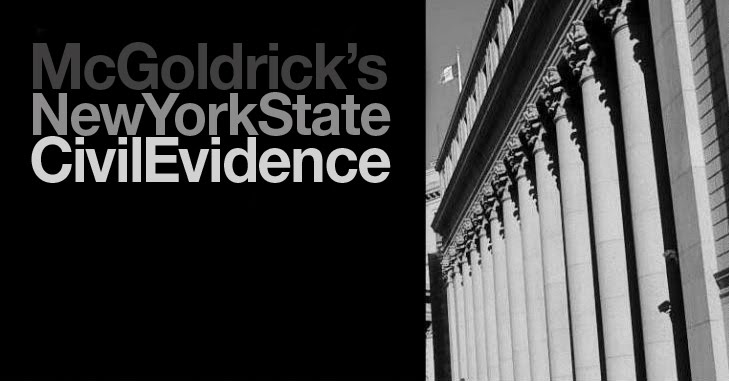In Hotaling v The City of New York 2009 NY Slip Op 04303 the Court of Appeals affirmed the decision of the First Department in Hotaling v City of New York 2008 NY Slip Op 07951 [55 AD3d 396] and held that the expert witness's testimony was insufficient at law to sustain a prima facie case of negligent design, referring to Buchholz v Trump 767 Fifth Ave., LLC 2005 NY Slip Op 04613 [5 NY3d 1].
The appellant had been awarded damages at trial before a jury for an accident that occurred while he was employed by the City. The basis of the appellants claim was negligent design. The appellant walked through a double swinging door during a fire drill and while turning right to continue to a staircase to exit the building was immediately hit by the second of the swinging doors being used by another exiting person.
At trial the appellant led evidence through an expert witness, the doors were negligently designed in that they allowed for an accident of the type in question, where a person was walking immediately to the staircase, that they were not restricted from swinging too quickly, and that the narrow viewing panel in the doors were too restrictive such as to prevent a person using the door from establishing it was safe to use. In contrast to the plaintiff, who did not lead any evidence that the City had violated the Building code at the time the building had been built, the City led evidence through its expert witness that the building design fully complied with the Building Code, and that the plaintiff's expert witness's conclusions that the design of the doors violated industry standard were erroneous.
First Department held:
The absence of a violation of the New York City Building Code may not always establish, as a matter of law, the absence of negligent design. Especially if there is no Building Code provision directly applicable to a particular design feature, other types of industry-wide standards may be applicable to determine whether a party was negligent. In either event, however, in this matter there is insufficient support for plaintiffs' negligent design claim. Before a claimed industry standard is accepted by a court as applicable to the facts of a case, the expert must do more than merely assert a personal belief that the claimed industry-wide standard existed at the time the design was put in place. Nor are mere nonmandatory guidelines and recommendations sufficient (see Diaz v New York Downtown Hosp., 99 NY2d 542, 544-545 [2002]; Capotosto v Roman Catholic Diocese of Rockville Ctr., 2 AD3d 384, 386 [2003]). The expert must offer concrete proof of the existence of the relied-upon standard as of the relevant time, such as "a published industry or professional standard or . . . evidence that such a practice had been generally accepted in the relevant industry" at the relevant time (Jones v City of New York, 32 AD3d 706, 707 [2006]).
In Buchholz v Trump 767 Fifth Ave., LLC (5 NY3d 1 [2005]), the Court affirmed a grant of summary judgment dismissing the complaint of a plaintiff who had accidentally fallen through a 13th-floor window in the course of roughhousing, where the plaintiff's expert had asserted that industry standards required installation of either tempered glass or a protective barrier bar, because "[p]laintiff's expert cited no authority, treatise, standard, building code, article or other corroborating evidence to support his assertion that good and accepted engineering and building safety practices" required these measures (id. at 8-9).
The essence of plaintiffs' claim was the assertion by Lustbader that the design of the doors at issue deviated from "human factors" design standards. Lustbader primarily relied upon the Human Factors Design Handbook, by Woodson and Tillman, for the industry standards he applied. However, he failed to establish that these purported standards were published, generally accepted, or even in existence in 1970. His testimony on that point was limited to his asserted "belief" that the first edition of the handbook "goes back some 30, 40 years," and that "the early versions predate 1970." However, not only did he fail to establish the existence of any such pre-1970 version, but also he did not verify that any such purported pre-1970 version contained the same standards as the later edition upon which he relied. Indeed, defendants established in their posttrial motion that the first edition of the Woodson handbook was published in 1981, rendering Lustbader's reliance on the standards set forth in the handbook inapplicable as a matter of law.
As to plaintiffs' contention that, although the handbook had not yet been published, the underlying principles were widely accepted prior to 1970, they merely cite three cases that discuss the admissibility of testimony regarding human factors standards without addressing whether the standard existed at the relevant time so as to be applicable to the facts at issue (see Wichy v City of New York, 304 AD2d 755 [2003]; Nowlin v City of New York, 182 AD2d 376 [1992], affd 81 NY2d 81 [1993]; Elmlinger v Board of Educ. of Town of Grand Is., 132 AD2d 923, 924 [1987]). While expert testimony as to human factors design standards has been ruled [*3]admissible, nevertheless, plaintiffs' expert failed to establish that the human factors design industry standards he relied upon were published or in general acceptance in the building construction industry in 1970.
Since the testimony of plaintiffs' expert failed to support plaintiffs' claim that the design of the doors in question violated accepted industry standards at the time the school was built, plaintiffs failed as a matter of law to make out a prima facie case of negligent design. The judgment must therefore be reversed and the complaint dismissed.
skip to main |
skip to sidebar



About The Author
- Gregory McGoldrick, Esq.
- Gregory McGoldrick, Esq., of the New York State Bar.
Since 2009, McGoldrick's New York State Civil Evidence, The Original New York Evidence Resource For Civil Practice Counsel - Straight To Your Android, BlackBerry or iPhone.
Table of Contents
- "human factor" standard
- "legally sufficient" evidence standard
- "utterly irrational" standard
- 1st Dept
- 2nd Dept
- 3rd Dept
- administrative proceeding
- admission in deposition testimony
- admission in former pleading
- admission in pleadings
- admissions against interest
- adverse inference limitation
- affidavit contrary to deposition testimony
- affidavit of service
- App Term 1st Dept
- appeal of directed verdict
- appeal of trial court's discretion
- burden of proof
- business records exception
- child support
- contempt
- contract of insurance
- cooperation clause
- Court of Appeals
- CPLR 2106
- CPLR 3101
- CPLR 3211
- CPLR 3212
- CPLR 4506
- CPLR 4506(1)
- CPLR 4513
- CPLR 4518
- CPLR 4518(a)
- CPLR 503(a)
- CPLR 5501
- criminal conviction
- damages based on probability
- Domestic Relations Law 245
- eavesdropping
- Education Law 6512
- email transmission
- exception to rule against hearsay
- excited utterance
- existence of liability insurance
- expert opinion based on independent report
- expert testimony
- expert witness
- felon witness
- former testimony
- foundation
- FRE 801(d)(2)(B)
- government agency guidelines
- hearing on service
- husband and wife
- implied revocation of authority
- incidental admission
- inconsistent facts
- inconsistent facts in expert testimony
- industry standards
- informal admission
- Insurance Law 5102(d)
- insured's statement to insurer
- intercepted communication
- judicial admission
- Judiciary Law 756
- medical expert
- medical records
- negligence
- negligent design
- New York State CPLR Civil Evidence Resource
- non mandatory guidelines
- Notice of Claim
- notice of condition
- official documents
- oral testimony in support of written Notice of Claim
- particularity
- Penal Law 156.10
- Penal Law 250.05
- photographs
- pleadings
- police accident report
- preclusion of expert witness
- present sense impression
- prevailing standards
- prima facie case of negligence
- prior conviction on plea
- prior notice of condition
- professional reliability exception
- proof of service
- qualification of expert witness
- qualification of expert witness\
- rebuttal of proof of service
- redaction of hospital records
- relevance of conviction to issue
- remoteness of time
- res ipsa loquitur
- retraction of admission
- rule against hearsay
- Section 50-H Examination of Claim
- Section 50-H General Municipal Law
- self-authentication
- serious injury
- spoliation of evidence
- stored communication
- summary judgment
- terms of request made of witness
- triable issue of fact
- unsworn expert evidence
Disclaimer
The information in this site is published as an interim point of reference for civil litigation counsel in the state of New York. There is nothing in this site that should be taken by you to be legal advice. Accessing or reading the information in this site does not create an attorney-client relationship between you and the author.
Return to McGoldrick's New York Civil Evidence
Since 2009, The Original New York Evidence, Disclosure & E-Discovery, and Deposition Practice Resource for Civil Practice Counsel - Straight To Your Android, BlackBerry, iPhone or iPad.
Since 2009, The Original New York Evidence, Disclosure & E-Discovery, and Deposition Practice Resource for Civil Practice Counsel - Straight To Your Android, BlackBerry, iPhone or iPad.
